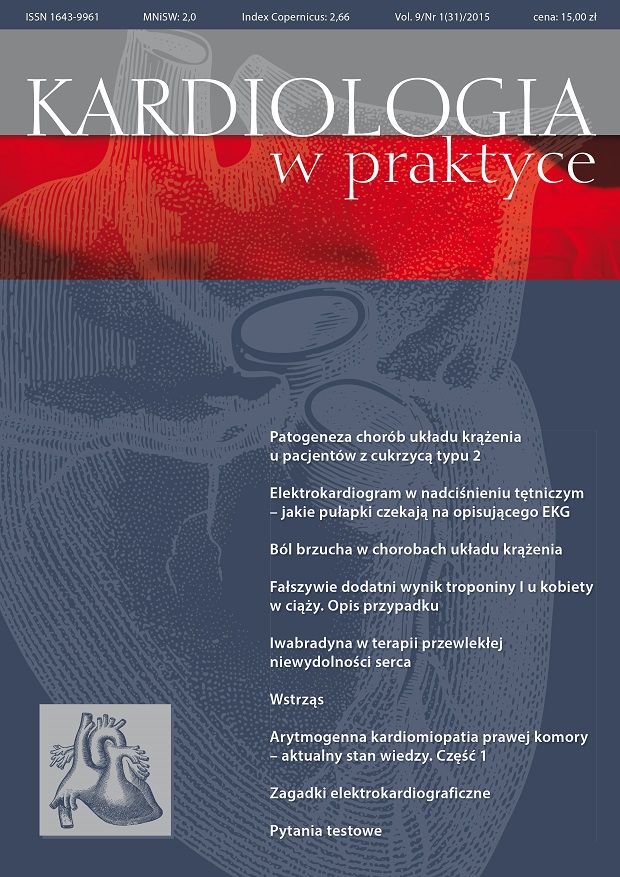Pathogenesis of cardiovascular diseases in patients with diabetes mellitus type 2 Review article
Main Article Content
Abstract
Cardiovascular disease is the main cause of increased mortality in diabetes patients. Myocardial infraction and stroke is in 60% to 80% causes reason of death in patients with type 2 diabetes mellitus. The main risk factors of cardiovascular disease are: hyperglycaemia, hyperinsulinaemia, insulin resistance, dyslipidaemia and hypertension. The other atherosclerosis risk factors are: smoking; increased levels of homocystein, C-reactive protein and fibrinogen. The key pathogenetic mechanism of diabetic vascular complications is increased oxidative stress due to chronic hiperglycaemia. Oxygen-derived free radicals cause lipoprotein oxidation, endothelial dysfunction, platelets hiperreactivity and blood clotting disorders. Determination of the role of this risk factors in patogenesis of diabetic angiopathy may be of significant importance in its effective therapy.
Downloads
Article Details

This work is licensed under a Creative Commons Attribution-NonCommercial 4.0 International License.
Copyright: © Medical Education sp. z o.o. This is an Open Access article distributed under the terms of the Attribution-NonCommercial 4.0 International (CC BY-NC 4.0). License (https://creativecommons.org/licenses/by-nc/4.0/), allowing third parties to copy and redistribute the material in any medium or format and to remix, transform, and build upon the material, provided the original work is properly cited and states its license.
Address reprint requests to: Medical Education, Marcin Kuźma (marcin.kuzma@mededu.pl)
References
2. Ceriello A., Motz A.: Is oxidative stress the pathogenic mechanism underlying insulin resistance, diabetes and cardiovascular disease? The common soil hypothesis revisited. Arterioscler. Thromb. Vasc. Biol. 2004; 24: 816-823.
3. De Vriese A.S., Verbeuren T.J., Van de Voorde J. et al.: Endothelial dysfunction in diabetes. Br. J. Pharmacol. 2000; 130: 963-974.
4. Lin K.Y., Ito A., Asagami T. et al.: Impaired nitric oxide synthase pathway in diabetes mellitus: role of asymetric diethylarginine and dimethylarginine dimethylaminohydrolase. Circulation 2002; 106: 987-992.
5. Cardillo C., Nambi S.S., Kilcoyne C.M. et al.: Insulin stimulates both endothelin and nitric oxide activity in the human forearm. Circulation 1999; 100: 820-825.
6. Stuehlinger M., Abbasi F., Chu J.W. et al.: Close relationship between insulin resistance and endogenous nitric oxide inhibitor. JAMA 2002; 287: 1420-1426.
7. Meigs J.B., Hu F.B., Rifai N. et al.: Biomarkers of endothelial dysfunction and risk of type 2 diabetes mellitus. JAMA 2004; 291: 1978-1986.
8. Tan K.C.B., Chow W.S., Ai V.H.G. et al.: Advanced glycation end products and endothelial dysfunction in type 2 diabetes. Diab. Care 2002; 25: 1055-1059.
9. Vogl-Willis C.A., Edwards I.J.: High glucose induced alterations in subendothelial matrix perlecan leads to increased monocyte binding. Arterioscler. Thromb. Vasc. Biol. 2004; 24: 858-863.
10. UK Prospective Diabetes Study Group: Tight blood pressure control and risk of macrovascular and microvascular complications in type 2 diabetes: UKPDS 38. BMJ 1998; 317: 703-713.
11. Birkenghager W.H., Staessen J.A., Gasowski J. et al.: Effects of antihypertensive treatment on endpoints in the diabetic patients randomized in the Systolic Hypertension in Europe (Syst-Eur) trial. J. Nephrol. 2000; 13: 232-237.
12. Hannson L., Zanchetti A., Carruthers S.G. et al.; The HOT Study Group. Effects of intensive blood pressure lowering and low-dose aspirin in patients with hypertension: principal results of the Hypertension Optimal Treatment (HOT) randomised trial. Lancet 1998; 351: 1755-1762.
13. Chirieac D.V., Chrieac L.R., Corsetti J.P. et al.: Glucose-stimulated insulin secrection supresses hepatic triglyceride-rich lipoprotein and apoB production. Am. J. Endocrinol. Metab. 2000; 279: 1003-1011.
14. Kornerup K., Nordestagaard B.G., Feldt-Rasmussen B. et al.: Transvascular low-density lipoprotein transport in patients with diabetes mellitus type 2. Arterioscler. Thromb. Vasc. Biol. 2002; 22: 1168-1174.
15. Sobel B.E., Woodcock-Mitchell J., Schneider D.J. et al.: Increased plasminogen activator inhibitor type-1 in coronary artery atherectomy specimens from type-2 diabetic compared with nondiabetic patients. Circulation 1998; 97: 2213-2221.
16. Keating F.K., Sobel B.E., Schneider D.J.: Effects of increased concentrations of glucose on platelet reactivity in healthy subjects and in patients with and without diabetes mellitus. Am. J. Cardiol. 2003; 92: 1362-1365.
17. Gresele P., Guglielmini G., de Angelis M. et al.: Acute, short-term hyperglycemia enhances shear-induced platelet activation in patients with type 2 diabetes mellitus. J. Am. Coll. Cardiol. 2003; 41: 1013-1020.
18. Żurawska M., Drzewoski J.: Insulinooporność, zespół metaboliczny, upośledzona tolerancja glukozy i cukrzyca typu 2 konsekwencją procesu zapalnego. Med. Metab. 2004: 7(1): 25-30.
19. Mosca L., Collins P., Herrington D.M. et al.: Hormone replacement therapy and cardiovascular disease: a statement for health professionals from the American Heart Association. Circulation 2001; 104: 499-503.
20. Duell B.P., Malinow R.: Homocysteine, B vitamins, and risk of cardiovascular disease. Heart 2000; 83: 127.
21. Christen W.G., Ajani U.A., Glynn R.J. et al.: Blood levels of homocysteine and increased risks of cardiovascular disease. Arch. Intern. Med. 2000; 160: 422.
22. Bostom A.G., Silbershatz H., Rosenberg I.H.: Nonfasting plasma total homocysteine levels and all-cause and cardiovascular disease mortality in elderly Framingham men and women. Arch. Intern. Med. 1999; 150: 1077.
23. Bostom A.G., Selhub J.: Homocysteine and arteriosclerosis. Circulation 1999; 99: 2361.
24. Miselli M.A., Nora E.D., Passaro A. et al.: Plasma triglycerides predict ten-years all-cause mortality in outpatients with type 2 diabetes mellitus. Cardiovasc. Diabetol. 2014; 13: 135.

